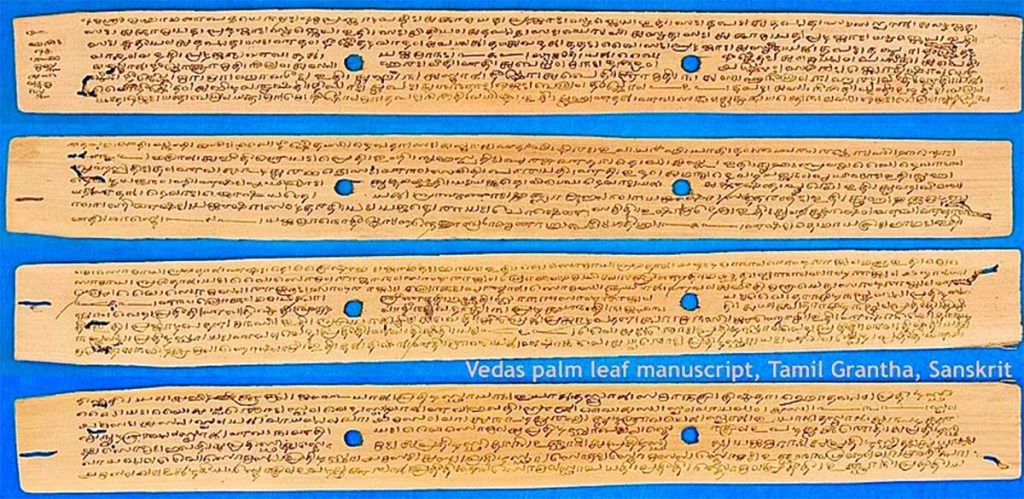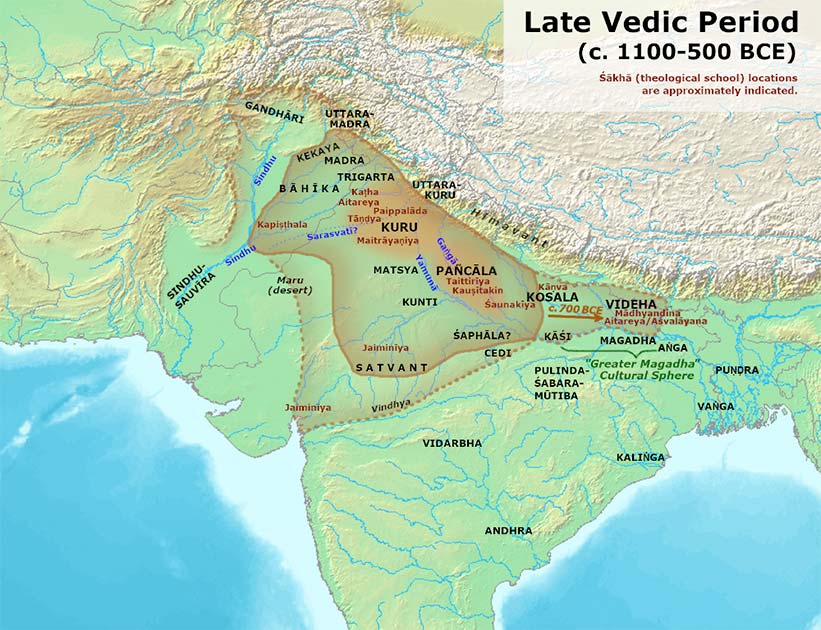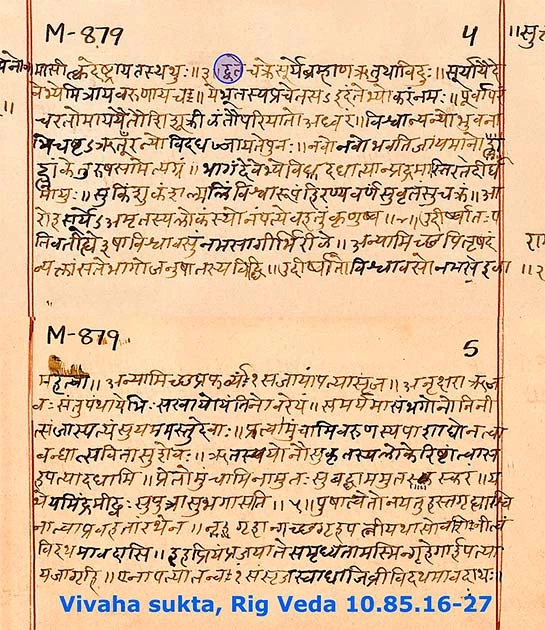The Quran is old. The Bible, and especially the Old Testament (or Jewish Tanakh) is even older. But religious tradition goes far further back than that, and to truly look into the origins of religious doctrine we need to go centuries earlier still, and look to the Rigveda.
Comprising a collection of ancient hymns and verses, the Rigveda holds the distinction of being one of, if not the oldest sacred texts known to humanity. The Rigveda is a truly fascinating text: not only is it a gateway to the profound wisdom of our ancestors but it has a lot to teach us about the religion that acted as a precursor to modern Hinduism as well as early religions in general.
This is everything you need to know about the Rigveda, its origins, its cultural importance, and why it stands out amongst the world’s oldest historical texts.
The Rigveda and the Vedic Tradition
The Rigveda, sometimes referred to as the “Rig Veda”, is an ancient collection of Indian hymns called sūktas written in Sanskrit. Originally composed in the northwestern regions of the Indian subcontinent between 1500 and 1200 BC the book is made up of different layers: the Samhita, Brahmanas, Aranyakas, and Upanishads.
The core text is known as the Rigveda Samhita which consists of ten separate books (mandalas) that contain 1,028 hymns in over 10,600 verses. These hymns are dedicated to various deities, with Agni, the god of fire, Indra, the god of thunder and rain, and Varuna, the god associated with cosmic order, featuring prominently.
Rigveda’s ten books cover a wide range of subjects. The oldest books, books 2 through 9, mostly cover topics around cosmology, rites, ancient rituals, and the worship of deities. The later books (1 and 10) are more philosophical and deal with topics like the origins of the universe, the nature of the divine, and the different virtues.

As a whole the Rigveda’s verses touch upon the mysteries of existence, the forces of nature, and the intricate relationships between humans and the divine. Remarkably, these hymns are not mere poetic expressions but serve as the foundation of Vedic thought, forming the basis for the religious and philosophical doctrines that later evolved into Hinduism.
- Vimanas, The Hindu Machines: Did Ancient India Have Flying Saucers?
- Kali Yuga: Why Hindus Believe We Live in the Worst World
So, if the Rigveda is a religious text, what religion does it belong to? Well, the Rigveda is an integral part of the Vedic tradition, a cultural and religious heritage that laid the foundations for Hinduism.
Its significance can be found in its name, Veda means knowledge while Rig means to praise, so its name literally translates to “Praise Knowledge.” Within the Vedic tradition, the Rigveda holds a central place as the oldest of the four Vedas, the others being the Yajurveda, Samaveda, and Atharvaveda.
The Vedic religion, also sometimes referred to as Vedicism, Vedism, or ancient Hinduism, first emerged among the Indo-Aryan peoples of the northwest Indian subcontinent around 1500 BC and lasted until roughly 500 BC when the religion began morphing into Hinduism. Many aspects of Vedic thought made their way into and inspired early Hinduism.
The Rigveda, with its hymns dedicated to deities and its insights into rituals, cosmology, and moral principles, serves as a vital source of knowledge that continues to influence not only Hinduism but also Indian philosophy, culture, and spirituality to this day.
The World’s Earliest Religious Text?
Many scholars consider the Rigveda to be the earliest religious text, but this is a little misleading. The Rigveda is certainly old; it can be traced back to a remarkably ancient period, with its composition dating back to around 1500 to 1200 BC. This places it among the oldest written texts in human history, predating many other religious and philosophical records.
It is also true that the Rigveda provides invaluable insights into the religious and philosophical beliefs of the early Indo-Aryan people who inhabited the Indian subcontinent during this era. It offers a window into their understanding of the divine, their reverence for natural forces, and their ritual practices.
It also laid the groundwork for subsequent Vedic texts and the development of Hinduism. It introduced key concepts and deities, including Agni, Indra, and Varuna, which continued to be central in later Hindu religious thought. The hymns and rituals described in the Rigveda set the stage for the evolution of religious practices in the Indian subcontinent.

Since Hinduism is widely considered to be the oldest major faith, and the Rigveda essentially holds its ancient building blocks, it’s easy to see why so many consider it to be the oldest religious text. However, depending on your definition of what a religious text is, there are other contenders.
For example, many of the Egyptian pyramid texts inscribed on the walls of the pyramids date back to 2400-2300 BC, making them roughly 1000 years older. Sumerian Cuneiform Tablets are also incredibly old. The Sumerians, one of the world’s earliest civilizations, left behind various religious texts, such as the “Epic of Gilgamesh,” which dates back to around 2100 BC, also beating the Rigveda.
We’ve already covered how the Rigveda is primarily associated with the Vedic tradition and the development of Hinduism, but it also offers valuable insights into the broader landscape of early religions. By examining the Rigveda alongside other ancient religious texts and practices, we can discern both commonalities and differences.
The reverence of natural forces and deities is a notable aspect of the Rigveda. Similar to other early religions, the Rigveda acknowledges the importance of forces like fire (Agni), thunder (Indra), and cosmic order (Varuna). This reflects a universal human tendency to seek spiritual connection through the natural world and to attribute things we do not understand to the divine.
Moreover, the Rigveda introduces the concept of rituals and sacrifices as a means to communicate with the divine. This practice resonates with the sacrificial rituals found in various early religions, displaying a shared human inclination towards appeasing higher powers through offerings.

On the other hand, the Rigveda’s intricate pantheon of deities and its emphasis on cosmic order provide a unique perspective distinct from many other early religions. In particular, it can be argued that the Rigveda’s cosmological musings make it far more philosophical than other early religious traditions.
In essence, while the Rigveda is rooted in the Vedic tradition, its themes, rituals, and philosophical ponderings can serve as a valuable point of comparison to better understand the common threads and unique aspects of early religions across different regions and cultures.
A Way into Religion
Whether or not the Rigveda truly counts as the world’s oldest religious text, its importance cannot be overestimated. It offers us a fascinating insight into the beliefs and traditions of the Vedic religion, in many ways a precursor to modern Hinduism.
Perhaps more importantly it offers a window into the common threads that bind early religions worldwide. To this day the Rigveda continues to inspire seekers of spiritual truth and scholars alike. Its ancient hymns are a reminder of the ancient human quest to understand the divine and our place in the cosmos. A quest that ultimately unites people of all faiths.
Top Image: Excerpt from the Rigveda, which offes a fascinating insight into the earliest religions. Source: Sarah Welch / CC BY-SA 4.0.